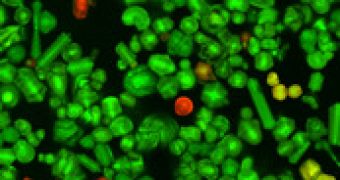Fluorescence is a luminescence that is mostly found as an optical phenomenon in cold bodies, in which the molecular absorption of a photon triggers the emission of another photon with a longer wavelength.
The energy difference between the absorbed and emitted photons ends up as molecular vibrations or heat. Usually the absorbed photon is in the ultraviolet range, and the emitted light is in the visible range. Fluorescence is named after the mineral fluorite, composed of calcium fluoride, which often exhibits this phenomenon.
In fluorescence, an initial ignition light energizes molecules, then the molecules reemit the light with a different color, phenomenon that can be used in many different applications because it is easily detectable, using optical filters to remove the ignition light, leaving only the particles' light visible. Igor Sokolov, Clarkson University Physics Professor, and his team have discovered a method of making the brightest ever synthesized fluorescent silica particles.
He has created a process to physically entrap a large number of organic fluorescent molecules inside a nanoporous silica matrix. The fluorescence of these particles is 170 times brighter than any particles of similar size created so far.
The possible applications for this new find address various fields, like biology, chemistry, medicine, forensic science, environmental protection and even robotics.
"We have already patented particles that can change color because of temperature change," he says. "The next step is to create a particle that would be a whole laboratory, simultaneously detecting many chemical environment factors -- temperature, acidity, metal ions, etc.
After that, we could make a nanobot, or smart drug, that would actively react to its environment, and be used, for example, in fighting cancer. Tumor tissue has a higher acidity than the surrounding tissue. As soon as the injected nanobot encountered the high acidity of a tumor, it would start releasing the drug it carries to kill the cancer."
Scaling down the size of these particles to nanosize (a thousand times smaller than now). "Should have a significant impact in biology," says Sokolov. "For example, you can create particles of different colors. These particles can be made 'sticky' to particular biological molecules inside cells. Then you can see those molecules easily. This fluorescent labeling helps to identify diseased cells and may show exactly what is causing the disease."

 14 DAY TRIAL //
14 DAY TRIAL //